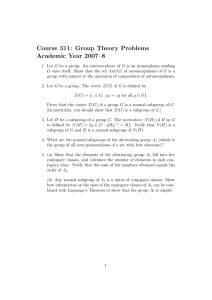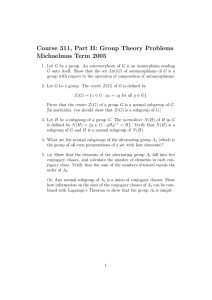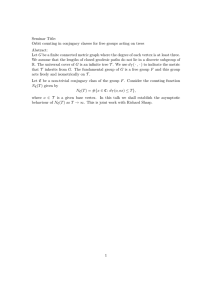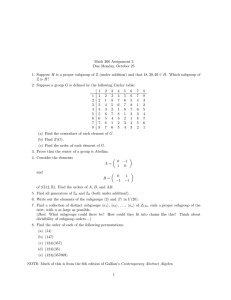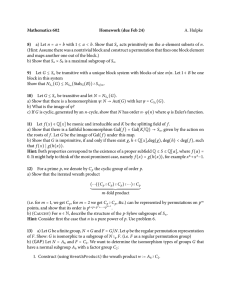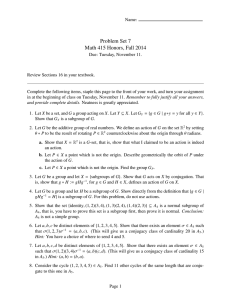On orbifold coverings of genus 2 surfaces a¨ at¨
advertisement
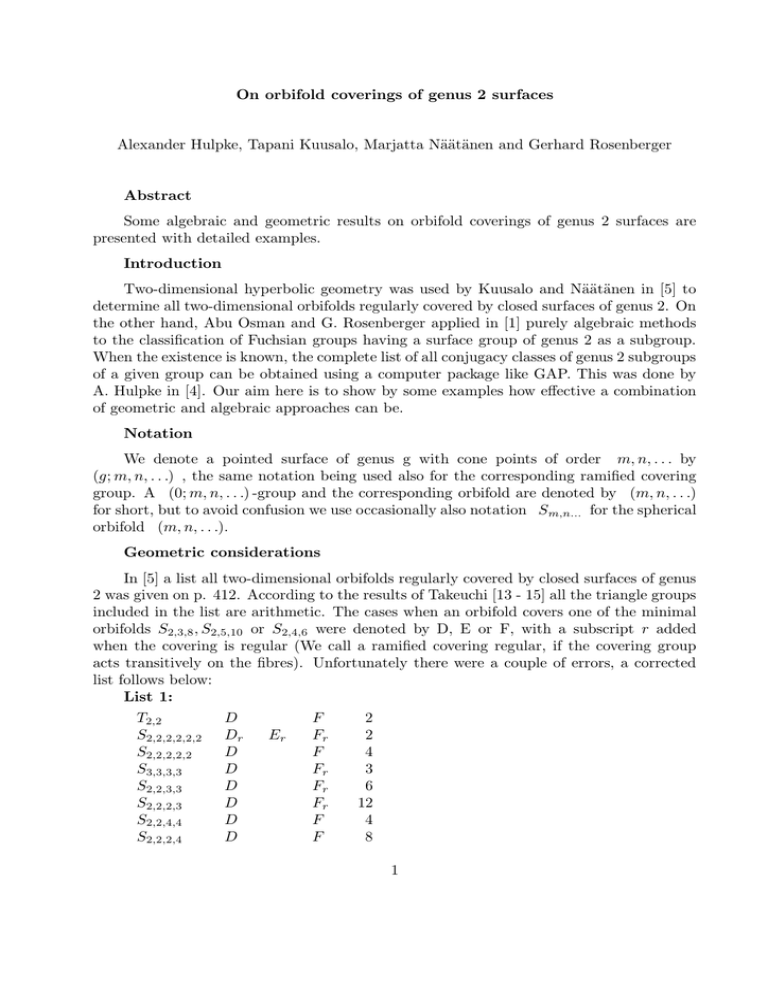
On orbifold coverings of genus 2 surfaces
Alexander Hulpke, Tapani Kuusalo, Marjatta Näätänen and Gerhard Rosenberger
Abstract
Some algebraic and geometric results on orbifold coverings of genus 2 surfaces are
presented with detailed examples.
Introduction
Two-dimensional hyperbolic geometry was used by Kuusalo and Näätänen in [5] to
determine all two-dimensional orbifolds regularly covered by closed surfaces of genus 2. On
the other hand, Abu Osman and G. Rosenberger applied in [1] purely algebraic methods
to the classification of Fuchsian groups having a surface group of genus 2 as a subgroup.
When the existence is known, the complete list of all conjugacy classes of genus 2 subgroups
of a given group can be obtained using a computer package like GAP. This was done by
A. Hulpke in [4]. Our aim here is to show by some examples how effective a combination
of geometric and algebraic approaches can be.
Notation
We denote a pointed surface of genus g with cone points of order m, n, . . . by
(g; m, n, . . .) , the same notation being used also for the corresponding ramified covering
group. A (0; m, n, . . .) -group and the corresponding orbifold are denoted by (m, n, . . .)
for short, but to avoid confusion we use occasionally also notation Sm,n... for the spherical
orbifold (m, n, . . .).
Geometric considerations
In [5] a list all two-dimensional orbifolds regularly covered by closed surfaces of genus
2 was given on p. 412. According to the results of Takeuchi [13 - 15] all the triangle groups
included in the list are arithmetic. The cases when an orbifold covers one of the minimal
orbifolds S2,3,8 , S2,5,10 or S2,4,6 were denoted by D, E or F, with a subscript r added
when the covering is regular (We call a ramified covering regular, if the covering group
acts transitively on the fibres). Unfortunately there were a couple of errors, a corrected
list follows below:
List 1:
T2,2
S2,2,2,2,2,2
S2,2,2,2,2
S3,3,3,3
S2,2,3,3
S2,2,2,3
S2,2,4,4
S2,2,2,4
D
Dr
D
D
D
D
D
D
Er
F
Fr
F
Fr
Fr
Fr
F
F
2
2
4
3
6
12
4
8
1
S4,4,4
S3,3,4
S2,3,8
S2,8,8
S2,4,8
S3,6,6
S2,6,6
S2,4,6
S3,4,4
S5,5,5
S2,5,10
Dr
Dr
Dr
D
D
F
Fr
Fr
Fr
Er
Er
8
24
48
8
16
6
12
24
12
5
10
Algebraic approach
All triangle groups which have a surface group of genus 2 as a subgroup have been
listed by Abu Osman and G. Rosenberger [1]. They used group theoretic arguments based
on Singerman’s theorem. Besides triangle groups there are other cocompact Fuchsian
groups having a genus 2 surface group as a subgroup of finite index.
Abu Osman and G. Rosenberger say in [1] that a group of type (g 0 ; m1 , m2 , . . . , mk )
has (g)–property if it has a (g; 0) subgroup for all g ≥ 2. In Theorems 3.5 and 3.7 of [1]
two lists are given:
List 2. Assume k ≥ 4 if g 0 = 0. Then (g 0 ; m1 , m2 , . . . , mk ) has (g)–property if and
only if (g 0 ; m1 , m2 , . . . , mk ) is one of the following groups:
(i)
(ii)
(iii)
(iv)
(v)
(vi)
(vii)
(vii)
(ix)
(x)
(xi)
(xii)
where N is the
(2,2,2,3)
N = 12
(2,2,2,4)
8
(2,2,2,6)
6
(2,2,3,3)
6
(2,2,4,4)
4
(3,3,3,3)
3
(2,2,2,2,2)
4
(2,2,2,2,2,2)
2
(1;2)
4
(1;3)
3
(1;2,2)
2
(2;0)
1
0
index of (2; 0) in (g ; m1 , m2 , . . . , mk ).
List 3. Let (l, m, n) be a triangle group. Then (l, m, n) has (g)–property if and only
if (l, m, n) is one of the following groups:
1.
2.
3.
4.
5.
6.
(2,3,7)
(2,3,8)
(2,3,9)
(2,3,10)
(2,3,12)
(2,3,18)
N = 84
48
36
30
24
18
2
7.
8.
9.
10.
11.
12.
13.
14.
15.
16.
17.
18.
19.
20.
21.
22.
where N is the
(2,4,5)
40
(2,4,6)
24
(2,4,8)
16
(2,4,12)
12
(2,5,5)
20
(2,5,10)
10
(2,6,6)
12
(2,8,8)
8
(3,3,4)
24
(3,3,5)
15
(3,3,6)
12
(3,3,9)
9
(3,4,4)
12
(3,6,6)
6
(4,4,4)
8
(5,5,5)
5
index of (2; 0) in (l, m, n).
All groups in the lists 2 and 3 can be isomorphically embedded into an arithmetic
triangle group, hence they have a realization as an arithmetic group, see also Ackermann,
Näätänen and Rosenberger [2].
For example (0; 2,2,2,3) is a subgroup of (2,3,7) with index 7. This can be seen as
follows: Singerman’s theorem (see Abu Osman and Rosenberger [1]) can be applied to get
(5 1 7 6 2 3 4)(2 5 4)(1 6 7)(3)(1 2)(3 4)(5)(6)(7) = (1)(2)(3)(4)(5)(6)(7).
For more details, see Maclachlan and Rosenberger [8], cf. also [7] and [9] as well as
Baer [3].
In [4] Alexander Hulpke used GAP low index calculations based on the algorithm of
Sims (Sims [12], 5.6) to determine up to conjugacy all genus 2 subgroups of the groups of
lists 1 and 2, giving at the same time also their generators in the containing groups. His
results were:
The group (2,2,2,3) has 39 conjugacy classes of genus 2 subgroups of index 12, of which
3 are normal (i.e. 3 conjugacy classes consist of just one subgroup). Correspondingly
(2,2,2,4) has 19 conjugacy classes of subgroups of index 8, of which 3 are normal, and
(2,2,2,6) has 3 conjugacy classes of subgroups of index 6, but no normal subgroups of
genus 2. In (2,2,3,3) there are 9 conjugacy classes of index 6, 3 of them normal, and in
(2,2,4,4) 3 conjugacy classes of index 4, one of them normal. In (3,3,3,3) all 3 conjugacy
classes of index 3 are normal, as well as the 10 conjugacy classes of index 4 in (2,2,2,2,2).
(2,2,2,2,2,2) has only one conjugacy class of index 2 which is thus normal. The group (1;2)
has 10 conjugacy classes of subgroups of index 4, and the group (1;3) 3 conjugacy classes
of subgroups of index 3, none of them normal. Finally, all 4 conjugacy classes of subgroups
of index 2 in (1;2,2) are normal.
The triangle groups in list 3 posses quite large number of conjugacy classes of genus
2 subroups. For a detailed account we refer to Neubüser [11].
3
Examples
Original ideas of Hurwitz can be used to decide geometrically whether a subgroup Γ
of finite coarea of a discrete subgroup G in PSL(2, R) is normal or not.
When G is a discrete group of finite coarea in PSL(2, R), the orbit space X = H/G
is a finitely punctured compact orbifold. If Γ ⊂ G is a subgroup of finite coarea and
Y = H/Γ the corresponding orbifold, the identification mapping f from Y = H/Γ to
b of the compactified Riemann
X = H/G extends to a holomorphic mapping fb : Yb → X
b
b the mapping f being induced by the action of a finite automorphism
surfaces Yb and X,
group A of the surface Yb exactly when Γ is normal in G. Should Γ be normal in G and
A = G/Γ the corresponding automorphism group, the order of an image point x
b = fb(b
y)
b can only be a multiple of the order of yb in Yb . Furthermore, if fb is induced by
in X
the automorphism group A, all points in an A-orbit orbit on Yb must have the same order.
This poses quite heavy restrictions for the automorphism group A, the full automorphism
group of a Riemann surface being usually rather small, or geometrically simple in the cases
when the surface is the sphere or a torus. For subgroups of some triangle groups this type
of reasoning works quite well.
Example 1. We construct first a normal tower of the regular covering of (2,4,8) by the
Bolza curve w 2 = z 5 − z of genus 2 (case D in Kuusalo and Näätänen [5], pp. 404-406).
f3
f2
f1
f4
Figure 1. g = 2
The covering group of the Bolza curve D has a regular octagon with diagonal pairings as a
fundamental domain, cf. Figure 1. The full conformal automorphism group of D contains
three conjugate subgroups of order 16, generated by two cyclic automorphisms of orders
4
8 and 4. Considering the hyperbolic area of the quotient orbifold one can thus see that
the normalizer (2,3,8) of the covering group Γ of D must contain three conjugate triangle
groups (2,4,8) of index 3. For one of these (2,4,8) groups we can choose the generators
S, T, U with relations
U 2 = T 4 = S 8 = I, ST U = I
and a corresponding fundamental domain
T
4
2
U
8
S
Figure 2. (2, 4, 8)
located in the regular octagon as indicated in Figures 2 and 3, where the fixed points of S
and T are Weierstrass points of the Bolza curve D. Here as well as in the diagrams that
follow we shade just one vertex in every orbit representing a cone point.
Figure 3.
The orbifold (2,4,8) is covered 2:1 by (0;2,2,2,4)
5
2
2
b1
2
U
c
4
Figure 4. (0; 2, 2, 2, 4)
The generators of the group (0;2,2,2,4) are c = S 2 , U, b1 = S −1 U S and (2,4,8) is obtained
by adjoining S to the group (0;2,2,2,4).
The orbifold (0;2,2,2,4) is covered 2:1 by (0;2,2,2,2,2)
2
2
b1
a
b2
2
b0
2
2
Figure 5. (0; 2, 2, 2, 2, 2)
The generators are a = U S 2 , b0 = S 4 = c2 , b1 = S −1 U S, b2 = S −3 U S 3 . The group
(0;2,2,2,4) is obtained by adjoining S 2 to the group (0;2,2,2,2,2). The orbifold (0;2,2,2,2,2)
can be also presented as
2
2
b1
a
2
2
b0
g1
2
Figure 6. (0; 2, 2, 2, 2, 2)
3
where g1 = SU S .
The orbifold (0;2,2,2,2,2) is covered 2:1 by T22 = (1;2,2), presented as a regular octagon
6
with all angles π
2 and two cone points of order 2.
2
b1
g1
g3
g2
b3
2
Figure 7. (1; 2, 2)
The generators of the covering group of T22 are
g1 = SU S 3 , g2 = S 2 U, g3 = S 4 U S 2 , b1 = S −1 U S, b3 = S 3 U S −3 ,
and one gets the group (0;2,2,2,2,2) by adjoining S 4 to the group (1;2,2).
T22 is covered 2:1 by the regular octagon with all angles π
4 and diagonal pairings
f1 = S 4 T 2 , f2 = ST 2 S 3 , f3 = S −2 T 2 S 6 , f4 = S 3 T 2 S,
which generate the covering group Γ = (2; 0) of the Bolza curve D. The group (1;2,2) is
obtained by adjoining either b1 of b3 to the group (2;0). Since T = S −1 U , we can also
write the generators of the genus 2 group as
f1 = S 3 U S −1 U, f2 = U S −1 U S 3 , f3 = S −3 U S −1 U S 6 , f4 = S 2 U S −1 U S.
The subgroups (0;2,2,2,4), (0;2,2,2,2,2), (1;2,2) and (2;0) form a desending normal tower of
(2,4,8). However, neither (0;2,2,2,2,2) nor (1;2,2) are normal in (2,4,8), for should (2,4,8)
act on either of the surfaces (0;2,2,2,2,2) and (1;2,2), the orbit of the fixed point of U would
contain points of different order. Cf. also the following example.
Example 2. The triangle group (2,4,8) which admits three conjugate embeddings in
(2,3,8) cannot be a normal subgroup of (2,3,8). The non-normality of (2,4,8) can be
reasoned also in a geometric way as follows:
Were (2,4,8) a normal subgroup of (2,3,8), the quotient group (2,3,8)/(2,4,8) would
have an operation on the orbifold S2,4,8 with S2,3,8 as the quotient orbifold. But the group
7
(2,3,8)/(2,4,8) would operate by Möbius transformations on the pointed sphere S 2,4,8 , and
excepting the identity, no Möbius transformation can preserve the orders of the three cone
points of S2,4,8 .
Example 3. It follows from Abu Osman and Rosenberger [1] that the (1;3) group
G = ha, b; [a, b]3i contains a (2;0) subgroup H = hx, y, u, v; [x, y][u, v]i with generators
x = aba−1 , y = b−1 aba−2 , u = b−1 ab, v = b2 . The group G can be given a
presentation in the triangle group (2,4,12) with generators S, T, U, U 2 = T 4 = S 12 =
I, ST U = I by setting a = T −2 U, b = T −1 U T −1 . In this presentation the subgroup
H has x = T −2 S 3 T −1 , y = T S 4 T −1 ST −1 , u = T S 3 , v = T −1 ST −1 S as generators and a regular hyperbolic 12-gon centered at the fixed point 0 of S as a fundamental
polygon:
3
4
A
2
5
1
6
B
O
7
12
11
8
10
9
Figure 8.
Denoting by k the common vertex of the sides k − 1 and k of the 12-gon we suppose
further that U fixes the midpoint of side 1, T respectively fixing the vertex 2. It can easily
be seen that H now identifies the side pairs {1, 11}, {2, 4}, {3, 9}, {5, 7}, {6, 12}, and
{8, 10}, the group H thus has the identification pattern 12.6 of Figure 2 in Näätänen and
Kuusalo [10]. We get the group G of the (1;3) surface by adjoining S 4 to the generators
of H. However, it is immediately seen from the diagram 12.6 of Figure 4 in Kuusalo
and Näätänen [6] that the rotation S 4 of order 3 does not preserve the set of Weierstrass
points of the genus 2 surface determined by H, so that H cannot be a normal subgroup
of G. But the rotation S 3 of order 4 is compatible with the identification pattern of H
and thus belongs to the normalizer N of H in SL(2,R), generating with H the subgroup
8
H 0 = hH, S 3 i of (2, 4, 12). The fundamental polygon P 0 of the group H 0 is given in
Figure 9:
D
A
E
C
O
B
Figure 9.
Now P 0 admits a further rotation R of order 2 with the intersection point E of the geodesics
AC and BD as a fixed point. Thus N = hH, S 3 , Ri is the normalizer of H in SL(2,R)
with the dihedral automorphism group D4 = N/H of the (2;0) surface determined by the
group H (case A on p. 404 in Kuusalo and Näätänen [5]). The domain in Figure 10
F
A
E
G
O
B
Figure 10.
where F and G are the midpoints of the boundary arcs AD and BC of P 0 , is the fundamental polygon of the normalizer N having non-equivalent fixed points of order 2 at
A, E and F , and respectively of orderp4 at O. The hyperbolic distance ρ between A
√
and F is quite small with cosh(ρ) = 1
3
+
3 ≈ 1.0877, which prevents the normalizer
2
N of being contained in any triangle group.
Remark. In the above pictures triangle groups and some symmetric Riemann surfaces
determined by their subgroups are presented. By deforming the fundamental polygon of
9
such a surface one gets examples of surfaces with less symmetry, where a corresponding
part of the normal chain in PSL(2,R) containing the surface group is lost.
References
[1] Abu Osman, M. T. and Rosenberger, G.: Embedding property of Surface Groups.
Bull. Malaysian Math. Soc. 2) 3 (1980) 21 - 27
[2] Ackermann, P., Näätänen, M. and Rosenberger, G.: The Arithmetic Fuchsian Groups
with Signature (0;2,2,2,q). Recent Advances in Group Theory and Low-Dimensional
Topology, Proc. German-Korean Workshop at Pusan, August 2000. Research and
Exposition in Mathematics Vol. 27 (2003) 1-9, 2003 Heldermann Verlag
[3] Baer, Christine: Klassifikation arithmetischer Fuchsscher Gruppen der Signatur
(0; e1 , e2 , e3 , e4 ). Dissertation, Universität Dortmund, 2001
[4] Hulpke, Alexander: Some subgroups of Fuchsian groups. Preprint 2002
[5] Kuusalo, T. and M. Näätänen: Geometric uniformization in genus 2. Ann. Acad. Sci.
Fenn. Ser. A.I. Mathematica, Vol. 20, 1995, 401 - 418
[6] Kuusalo, T. and M. Näätänen: Weierstrass points of genus-2 surfaces with regular
fundamental domains. Q. J. Math. 54, 2003, 355 - 365
[7] Maclachlan, C. and G. Rosenberger: Two-generator arithmetic Fuchsian groups. Math.
Proc. Cambridge Philos. Soc. 93, 1983, 383 - 391
[8] Maclachlan, C. and G. Rosenberger: Two-generator arithmetic Fuchsian groups II.
Math. Proc. Cambridge Philos. Soc. 111, 1992, 7 - 24
[9] Maclachlan, C. and G. Rosenberger: Commensurability classes of two-generator arithmetic Fuchsian groups. Discrete Groups and Geometry (ed. by W.J. Harvey and C.
Maclachlan); London Mathematical Society Notes 173, Cambridge University Press
1992, pp.171-189
[10] Näätänen, M. and Kuusalo, T.: On arithmetic genus 2 subgroups of trianglegroups.
Contemporary Mathematics, Vol. 201, 1997, pp. 21 - 28
[11] Neubüser, J.: Personal communication
[12] Sims, Charles C.: Computation with finitely presented groups. Cambridge University
Press, 1994
[13] Takeuchi, K.: A characterization of arithmetic Fuchsian groups. J. Math. Soc. Japan
27, 1975, 600 - 612
[14] Takeuchi, K.: Commensurability classes of arithmetic triangle groups. J. Fac. Sci.
Univ. Tokyo. Sect. IA Math. 24 1977, 201 - 212
[15] Takeuchi, K.: Arithmetic Fuchsian groups with signature (1;e). J. Math. Soc. Japan
35, 1983, 381 - 407
Alexander Hulpke
Department of Mathematics
Colorado State University
1874 Campus Delivery
10
Fort Collins, Co 80523-1874
USA
Tapani Kuusalo
Matematiikan ja tilastotieteen laitos
Jyväskylän yliopisto
PL 35
40014 Jyväskylä
Finland
Marjatta Näätänen
Matematiikan ja tilastotieteen laitos
Helsingin yliopisto
PL 68
00014 Helsinki
Finland
Gerhard Rosenberger
Fachbereich Mathematik
Universität Dortmund
44221 Dortmund
Germany
11
